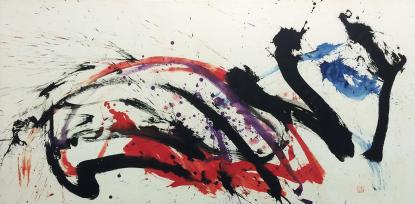Kazuo Shiraga
Kazuo Shiraga was a Japanese painter and performance artist born in Amagasaki, near Kyoto. In 1948, the artist graduated from the Kyoto City Specialist School of Arts, now known as the Kyoto City University of Arts, where he learned traditional Japanese painting. However, the artist was more attracted to the Western artistic style. In 1952, he co-established Zero-kai (the Zero Society), an avant-garde conceptual group with other artists including Akira Kanayama, Saburo Murakami, and Atsuko Tanaka. The group was renowned for its belief that works of art are created from nothing. In 1959, Zero-kai joined a broader artistic movement, the Gutai Art Association led by Jirō Yoshihara, which encouraged detachment from social involvement and embraced pure abstraction.
Kazuo Shiraga echoed the belief of the movement by creating works like Challenging Mud in 1955, in which he used his whole body to wrestle through a mixture of clay and cement to the point of exhaustion. He then embarked on his iconic Performance Paintings in 1956. Inspired by the American artist Jackson Pollock, the artist applied oil paint to large surfaces such as paper sheets or canvas on the floor. He would use a rope that hung from the ceiling and swing on top of the picture plane before an audience, allowing only his feet to touch the paint. Through the swinging movement, sometimes choreographed and sometimes spontaneous, a dynamic style unique to the artist was formulated. Shiraga continued to explore the relationship between the body and artistic media throughout his long career.
In 1971, Shiraga entered the Buddhist priesthood of the Enryaku-ji Monastery of Mount Hiei, where he continued to paint under his monk name, Sodo, until his death in 2008.
While Shiraga received considerable praise in Japan and Europe during his lifetime, his work didn't gain recognition in the USA until after his passing. This was corrected with exhibitions such as Destroy the Picture: Painting the Void, 1949-1962 at The Museum of Contemporary Art in Los Angeles (2012-13); Tokyo 1955-1970: A New Avant-Garde at The Museum of Modern Art, New York (2012-13); and Gutai: Splendid Playground at the Solomon R. Guggenheim Museum, New York (2013). Today, Shiraga's paintings can be found in the permanent collections of the National Museum of Modern Art and the Hara Museum of Contemporary Art in Tokyo; the Hiroshima City Museum of Art; the Dallas Museum of Art; the Walker Art Center in Minneapolis; and the Centre Pompidou in Paris.

SELECTED WORKS

Kazuo Shiraga, Untitled, 1980
Watercolour on paper
90,5 x 180 cm | 35.6 x 70.9 in

Kazuo Shiraga, Untitled, 1980
Watercolour on paper, laid down on board
90,5 x 180,5 cm | 35.6 x 71.1 in

Kazuo Shiraga, Work
Watercolour on paper
24 x 33 cm | 9.4 x 13 in

Kazuo Shiraga, Atusi Akashi, 2003
Oil on canvas
97 x 131 cm | 38.2 x 51.6 in